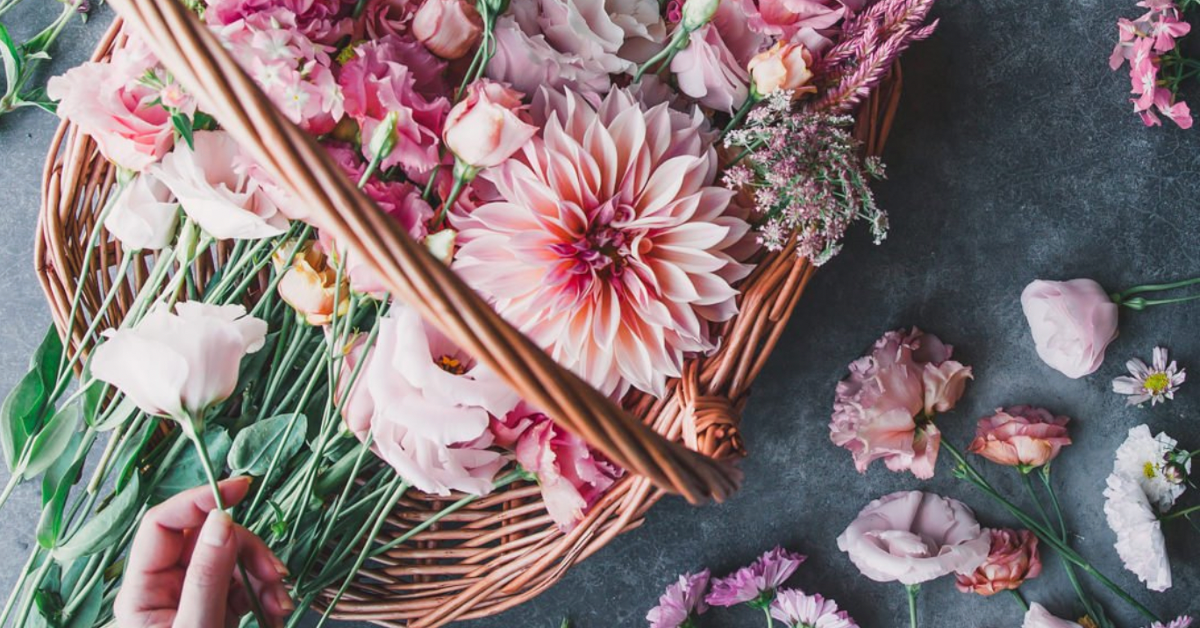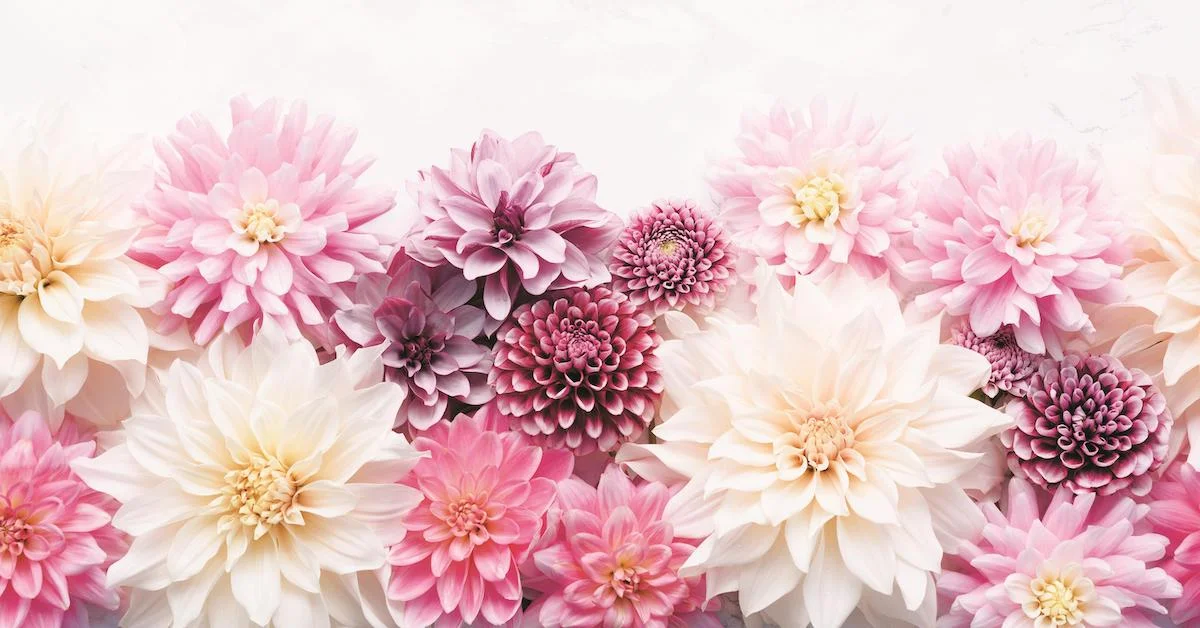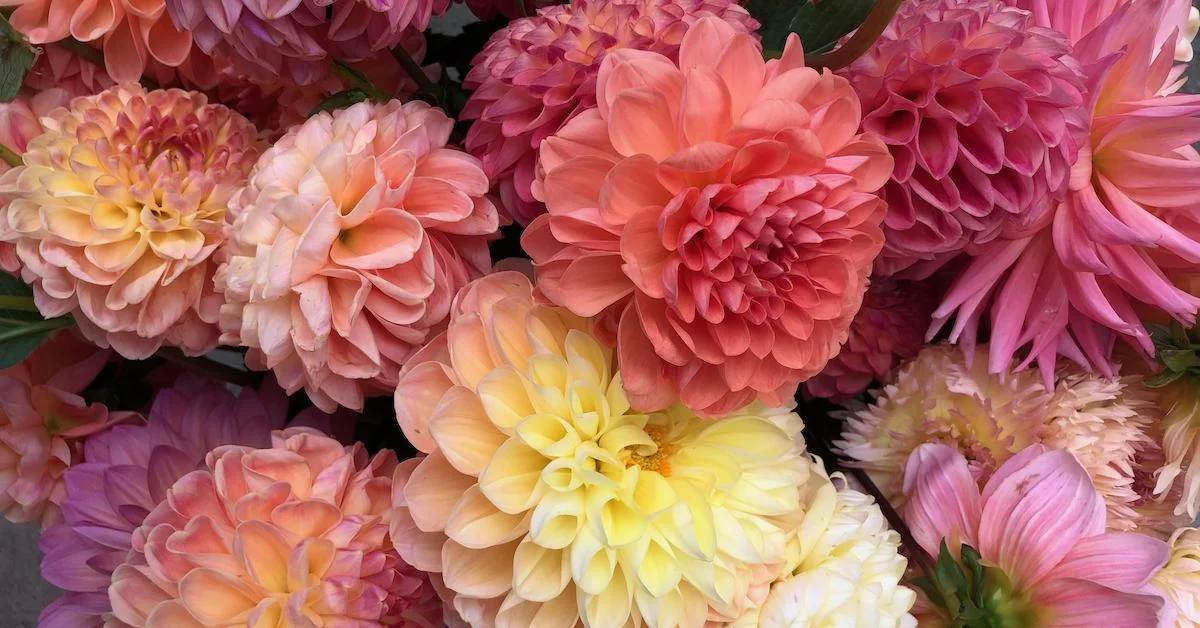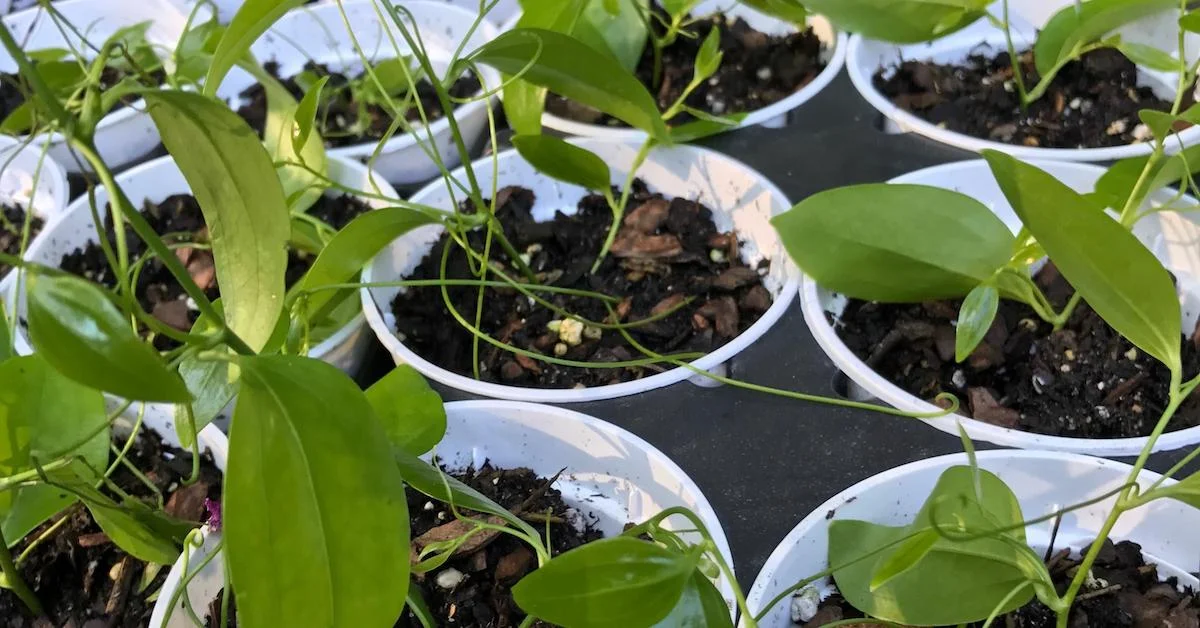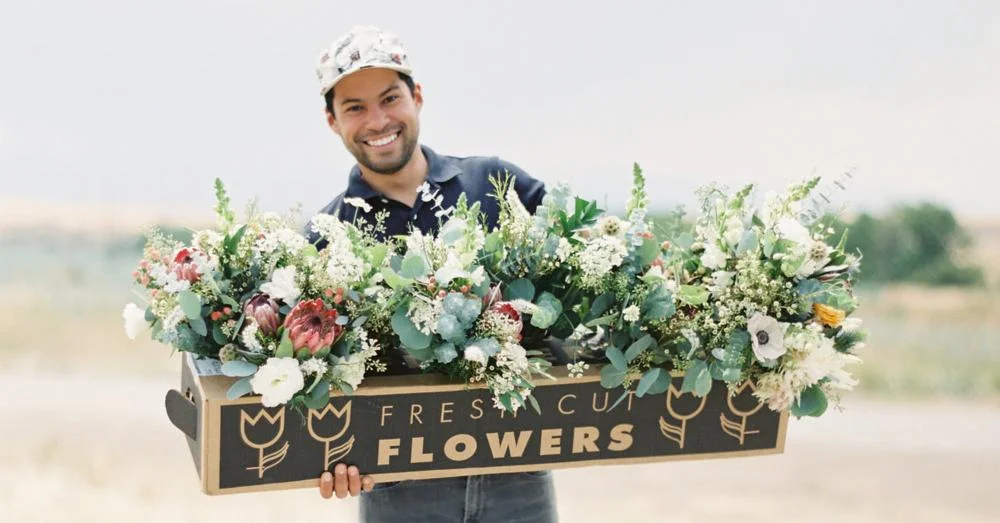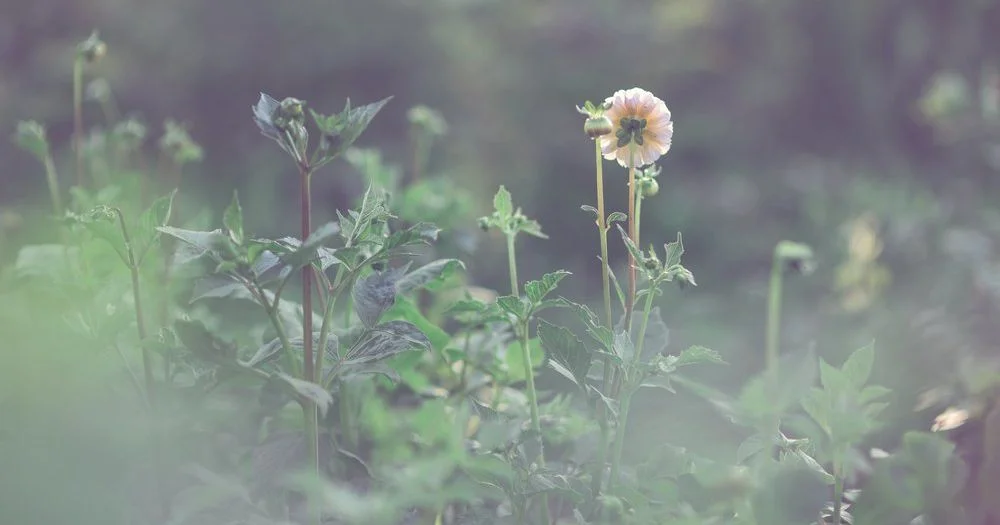Maggie Hyde of Petal Back Farm joins us on the Team Flower Podcast to share tips on so many different aspects of farming.
All tagged dahlias
Planning a Flower Farm with 1818 Farms
Natasha McCrary of 1818 Farms is full of knowledge and has years of experience planning a farm, growing flowers, and leading a team (amongst other things). She’s constantly learning and is more than willing to share what she knows with the floral industry. This podcast episode is sure to be a treat!
The Details of Dahlias: Diversity, Hybridization, and Growth
LeeAnn Huber of Coseytown Flowers is talking with us on the podcast about seeds versus tubers, diversity, hybridization and so much more! She’s sharing in detail how the process of dahlia hybridization works, in addition to diving into how florists can support their local farmers, what it looks like to pause in your business’s growth to bloom yourself, and how to give and receive grace within a partnership.
The Power of Practice with Triple Wren Farms
Listen in to hear floral designer and farmer Sarah Pabody chat about the power of practicing floral design as an art form, growing dahlias, her top 4 tools for floral installations, and more! At Triple Wren Farms, Sarah and her team grow dahlia tubers, fresh cut flowers, and offer workshops at the farm in Washington State.
Video: How to Stake Dahlias
In this video, Linda Doan, Specialty Cut Flower Grower from Aunt Willies Wildflowers in East Tennessee shows you how she cares for 700 dahlias, a backbone in her wedding-based growing business. Cutting and staking dahlias easily is a priority for Linda and her husband Roy and this is a quick peek inside how they do it. You can modify this double-row staking technique for other farm and garden flowers.
————————
Transcript:
Hello Team Flower, my name is Linda Doan. I own Aunt Lily's Wildflowers here in east Tennessee, and I'm about to tell you all you need to know about netting dahlias. Okay, this is our dahlia set up, and the supplies that you need are T posts, which are heavy duty posts. We drive in with a post hole driver, where we just pound it on the post hole, and down in the post, and we have these. These are actually tobacco stakes. We have this Hortanova or tenax netting that you can Google online or you can find it at Nolts, N O L T S. It has six inch squares and we separate it with this tobacco stake at the end to keep it wide. We have a lower row and a higher row, and these dahlias, these are just starting to bloom and you can see they're already up through the second row, so when wind comes and blows, we don't have to worry. They come up through the first row, through the second row of netting, and will not topple. We will deep cut them or they might even topple. We've had 'em get so big that they'll topple two rows of netting, so we try to keep 'em at a workable length, but a very good system when you have 700 dahlias in the ground, you don't want to have to be staking each one. This allows you to mass stake and does it very well and allows you to cut very easily.
Working with Native Plants with Lee Carlton
Located in the North Carolina mountains, Lee has been a been a horticulturist for 23 years and has worn many hats throughout that time. She grows and selects dahlias based on color, form, and vase life specifically for floral design and then sells the tubers. She supplies local florists with dahlias and native species that she has also tested. Lee also designs, installs, and maintains several large, naturalistic gardens with a focus on native plants, including a vertical wall garden loaded with species that grow from the rocks in North Carolina.
Video: How to Divide Dahlias
In this video we share how to divide dahlia tubers. Susan has been doing it for over 20 years, has tried all kinds of methods and is sharing her favorites. Jump in to learn about tubers, eyes, and dividing dahlias!
-------------
Transcription:
Hi. My name's Kelly. And I'm here with my friend Susan from Shady Grove Gardens. Susan and her husband Brent grow wonderful dahlias up at their mountain farm. And so I asked Susan to come over today and tell us a little bit how to divide dahlias. And I also wanted to tell you a little bit about the dahlia workshop that she has coming up this July. Tell us a little bit about it.
It's July 31st. And we're going to have one day of very intensive everything you need to know about dahlias. So it'll be planting, staking, dividing, design. We're going to spend a little bit of time with little tricks and tips on how to design. How to cut them, how to do disease control.
They also get a lot of insects, so we're going to go over insect control, and the hard parts, planting and harvesting and digging them up in the fall, and then how do you store them. And today, we're going to do the division. But we're going to cover everything else at the workshop.
Perfect. That sounds super fun. I bet you'll have like all the different varieties and kinds that you would recommend. So you're thinking you might want to start growing dahlias, there are all kinds of varieties out there. But Susan's been doing this for a long time and she knows the ones that really work well for her. So she'll be sharing all of that at the workshop, which is really exciting.
So tell us what we're looking for and how we need to do this. These are Cafe au Laits from my little backyard garden. And I've never divided them before. I know that there's eyes and that that's important.
Well, there are several different ways to do it. And I'm actually very conservative, because they're mine and I'm not shipping them off usually and I'm not trying to make hundreds out of it. So I might leave something like this for myself. But I start by clipping off all the little, what lot of people call as hairy bits.
Get rid of all those hairy bits.
And that makes it just a little bit easier to see. Now, you can divide the dahlias, either in the fall, right after you dig them up, which makes it a little easier to see the eye.
Show us what the eye looks like over here.
So the eye is these little tiny bumps here.
Right around the kind of top. So this kind of looks like a little magnolia pod, doesn't it? And then, it's tiny. And then, you get this little bit of a bump right there.
And it's always attached to the stem. So when you divide them, you always want a little bit of the stem to remain. So on this particular one, if you think there's two or three eyes in there, and you can also see, possibly, two or three eyes back here. So what you want to do is leave some piece of the stem, because that's where you think the eyes are going to be.
So here, I'm cutting up through the middle of the stem. And this part isn't necessary.
Goodbye stem piece.
So then, if you really wanted to make three out of this, you could cut it again. But if you want to be conservative, you just cut it like so. So this has sort of this little neck here. And that's where I would expect the buds to come out.
So the buds, or the new growth, is actually going to be coming out of that eye.
All the growth will come out of there. And of course, it will form roots.
So if we cut the eye off, then we just cut off anything that would be viable.
Right. You can, if you have these here that are-- see how this is broken, what I would call broken, the neck's broken.
Cracked.
So these, most likely, will not do anything. So often, we will clip those off. But we'll keep this and that should come out. Now, this one's a little on the shriveled side, but it should be OK, if it doesn't continue to shrivel. We store ours-- we've gone through a lot of different trial and error, sometimes they'll rot, sometimes they don't. But this year we've decided that pine bark or the bedding that you use for pets--
Like hamsters?
Like hamsters, like those little chips you buy at the store, those big bags, that seems to be our best bet for storing. So it doesn't keep them wet, it doesn't keep them any drier. We do have the whole bins all the sets of bins with the chips shavings in there, are all also surrounded with plastic so they don't lose-- you also want to store them about 40 degrees. Now, our garage is not 40 degrees.
Yeah. This isn't either.
So we try.
Do they need a cold period? Or it's more or less for preserving them?
Yeah. They're from the Andes. But they do not need a cold period. So think of them like a tomato. It's a tropical plant. It just needs a little rest, because in North America, it's too cold for them.
That's interesting that it was a tropical plant.
Yeah. So whenever people say like that it's too hot or that it needs that-- I guess, and you know this, because you're a Costa Rica girl-- the swing of the temperatures, like day to night, but people in Florida it just doesn't get cold enough for them, or if they're like they're on the coast.
They're from the Andes.
Educate me.
The mountains, the cool summer nights, cool days, that's where they're the happiest. That's their origin.
When you said tropics I immediately thought I'm going to the Bahamas now and I was like, wait a second.
But that's where the wild ones are. So they probably originated somewhere near where potatoes originated and they act a lot like potatoes.
Interesting. So this one here, would you say, if you do you have that broken neck, would you just leave it on and plant it? It's not going to do any harm, but--
Yeah. I probably would, just hoping that it might be OK. , Now, one that's really badly damaged, like this one, I'd probably clip it off. And I didn't used to do that. But just for storage space. And then, you don't want the rot. If it rots, you don't want it to spread to the rest of the plant. So ideally, you don't want them to shrivel quite that much.
Show the bad example.
But this will still have a good potential to sprout. I don't think I would divide it more, although some people might. You can clip the stem off, just don't clip down too far, because every once in a while, the buds will come out right here.
Now, this one is more challenging. So you would need, probably, a sturdier knife and really cut into that. You could use clippers or even loppers.
Yeah. This is hard.
So that's another reason to maybe do them in the fall, when they're a little softer.
Right. So basically, I dug these. I left them in soil and I kept them in a pot in a cool room of the house.
Cool's good. Cool's good. And then, you want fairly high humidity so they don't dry out. And like I said, 40 degrees, 60 degrees. We start opening our garage windows if it gets above that and hope for the best in this warm weather.
So recap. We're getting rid of the hairy bits. Step one. Step two--
Makes it a little easier to see what's going on.
Yeah, it's easier to see what's happening.
And you knock off the dirt. In my case, I'm knocking off rocks, because we have lots of rocks. And we're trying to get those out between the tubers. But the next step is what most people are afraid to do, is to really just go right on in there. And you are going to lose--
Look at this one. What's happening here?
That is probably the mother. Actually this one's the mother. So that's the one you had last year.
Oh, OK.
So it's usually a little rougher, it could even be hollow.
Will it produce again?
No. So you could remove that and not miss it.
Let's get a close up of what the mother looks like.
So this one is the mother. So that's last year's tuber. And then, all of these formed over the summer last year.
So then, usually, I'll go in with something like clippers and cut into the stem. But these won't do that. So we're just going to show you.
Is there something else I can give you?
Nah. I think maybe I could just switch to another.
Yeah. We'll just switch to another one. And there's all kinds of different tools that you can use to get these going, even the little-- I'm not sure what it's called.
It's like a Dremel tool.
It's like a Dremel tool.
Or those tiny Sawzall. And you can get small and large blades. We use a little narrow one, about the width of my finger. And it's heavy and it's not cheap, if you have a lot of dahlias, you're going to want to do it. So then, we go in and it just goes--
[BUZZING]
--and it just cuts, like that. And then, it's a little easier.
So here's one of your eyes.
And you can see, it looks like it's like sprouting now, this little bit of green.
Yes. It's starting to sprout, because we've had a little bit of a warm spell. So if you wanted to get them started early, you could put it in a pot.
Put it in a pot and starting babying it a little bit.
Yeah, but then you have to care for it everyday.
Do you get an earlier bloom, or what's the benefit of--
Yeah. You get an earlier bloom. And then, those people that really want more dahlias can do cuttings. But that's a whole other project.
So on this one, it's a little easier to see where you might cut it. And so you just cut in there. And you still have multiple buds. And on this one, hopefully, we still have multiple buds there.
Yeah. Can you see this? You can see, up around this eye, how there's already even these little buds that are starting to pop out. So cool. So there's a plant. And here's one. And here's one. And here's one, maybe two?
Yeah. Maybe two, if you're feeling brave.
I don't have enough room, so I won't feel brave. I'll just--
Since these are Kelly's, I'm not going to cut it up more.
And since I don't have a lot of room, I don't need-- look at all these. It's amazing how, this was three plants. So here and now we already have three more plants coming up this year.
Especially if you're doing this in the fall, you want to let this sort of seal over before you were to put it in some--
To store it.
Don't do what I did. Don't put them in Ziploc bags and store them. You will kill them. All mine rotted one year when I did that. So you do want to use some sort of loose bedding, newspapers, shavings, or something like that. But you also, just give it a day or two, like a potato that you've cut up and let it seal over and you should be good to go there.
Well, Susan, thank you so much for coming to tell us and share what you know about the dahlias and dividing them. This has been really helpful. And now, all my dahlias are ready to get potted up and I guess to get an early bloom, get started out there.
So thanks so much for coming. We look forward to seeing you. And for those of you who come to Susan's workshop, we can't wait to see you soon.
Award-Winning Tips on Snowdrops, Orchards, and Dahlias with Naomi Slade
We are chatting about the three books Naomi has written—one on snowdrops, one on orchards, and the most recent on dahlias. You’ll hear about fruit trees and the roles they have played (and continue to play) in our lives, you’ll learn about the sweet, delicate snowdrop and how to grow and care for them, and Naomi is also walking us through her book on dahlias and sharing several helpful tips on growing dahlias successfully.
Comprehensive Dahlia Variety Guide by Color
The flowers of dahlias offer such a fantastic range of color, size, and form that it is hard to resist trying out every variety.
Microfarming in Every Season: One Farmer’s Advice
Kelly Wood shares how she converted two acres around her house to a microfarm to augment her floral design business and add beauty and refuge for wildlife. It eventually turned into a commercial cut flower and foliage farm supplying floral designers in her area.
Julio Freitas of The Flower Hat
Julio Freitas, founder of The Flower Hat, joins us on this episode of the Team Flower Podcast. We are chatting about the story behind the hat, the beginnings of the farm, and our love for daffodils and dahlias!
How to Grow Dahlias
In this article, we share with you a few things about growing the beautiful dahlia: the great queen of the summer. The dahlia never ceases to dazzle us! Team Flower member Jessica Weatherford, after growing 250 dahlia plants, is in the process of tripling her crop this year and shares how to grow them with success.

